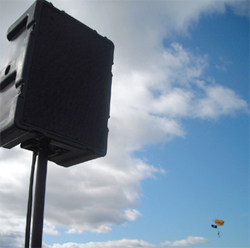
The frequency response of the loudspeakers should be wide enough to reproduce the sound source accurately.
For speech only, 100 Hz – 12 kHz is usually sufficient, but a guitar-singer application is better served by 80 Hz – 15 kHz and a rock band really should have 40 Hz – 15 kHz or higher.
Those frequency limits are typically 10 dB down or less from the level at 1 kHz.
Of course, the flatter the response over the passband, the more accurate the reproduction.
Boosting The Boom
This brings us to subwoofers. Dynamic music performances can really benefit from extended low-end energy.
The majority of full-range portable loudspeakers also offer at least one companion subwoofer, typically loaded with a 15-inch or 18-inch woofer.
These usually include mounts to accommodate stand poles, and sometimes have wheels on their back floor edge for easier transport.
An option for music applications is a subwoofer/satellite configuration, where one or two subwoofers on the floor provide deep bass, while two compact satellite loudspeakers on stands provide the rest of the spectrum.
Because our ears don’t localize extreme low frequencies, all sound “appears” to come from the satellites. The advantage of this approach is not having to lift large, heavy loudspeakers for positioning on stands.
Column loudspeakers are having an influence on portable PA designs, and that’s no surprise considering that the Shure Vocalmaster system, one of the most popular portable systems in the 1960s-70s, also featured a column approach.
A recent example is the Fishman SA220, which incorporates six 4-inch mid-woofers in a vertical line topped by a 1-inch soft-dome tweeter, housed in a cabinet measure just over 5 inches wide by 6 inches deep.
It’s self-powered and comes equipped with two mic/instrument channels with high-quality preamps, each with 3-band EQ, phantom power, built-in reverb, effects loop, notch filtering and phase controls.
A popular configuration is to place the SA220 behind the performer/group, where it can serve as both mains and monitors. Another common set is one SA220 per performer.
The advantages are that the performer(s) hear the same mix that the audience hears, and the sound level is more constant with distance than with a woofer/horn system.
